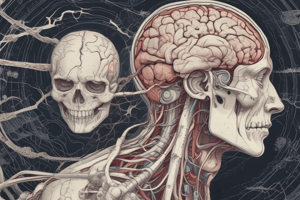Podcast
Questions and Answers
Which part of the brain is responsible for connecting various regions and enabling communication?
Which part of the brain is responsible for connecting various regions and enabling communication?
- Reflexes
- Synapses
- White Matter (correct)
- Neurotransmitters
What is the main function of grey matter in the brain?
What is the main function of grey matter in the brain?
- Strengthening existing neural connections
- Allowing communication between brain regions
- Processing information and controlling muscle movements (correct)
- Transmitting signals across neurons
What process involves the formation of new neural connections and the reorganization of pathways in the brain?
What process involves the formation of new neural connections and the reorganization of pathways in the brain?
- Neuroplasticity (correct)
- Synaptic transmission
- Reflex response
- Brain injury
What is the role of neurotransmitters in brain communication?
What is the role of neurotransmitters in brain communication?
Which disease is characterized by memory loss, impaired thinking, and behavioral changes?
Which disease is characterized by memory loss, impaired thinking, and behavioral changes?
How do reflexes contribute to the brain's function?
How do reflexes contribute to the brain's function?
What is the main function of the cerebrum?
What is the main function of the cerebrum?
Which part of the brain is responsible for coordinating muscle movements and maintaining balance?
Which part of the brain is responsible for coordinating muscle movements and maintaining balance?
What is the function of the brainstem in the human body?
What is the function of the brainstem in the human body?
Which part of the brain connects the left and right hemispheres?
Which part of the brain connects the left and right hemispheres?
What is the weight of the average adult human brain?
What is the weight of the average adult human brain?
Which component of the brain sends electrical and chemical messages to facilitate communication?
Which component of the brain sends electrical and chemical messages to facilitate communication?
Study Notes
Exploring the Human Body's Complex Puzzle: An Overview of Our Parts, Starting with the Brain
The human body is an intricate and interconnected network of systems, tissues, and organs, each playing its unique role in keeping us alive and thriving. When diving into the world of body parts, our journey begins at the center of our cognitive abilities and decision-making: the brain.
The Brain
The brain is a soft, spongy organ, weighing about 1.4 kilograms (3 pounds) in the average adult. It is encased within the protective skull and is divided into three main sections: the cerebrum, the cerebellum, and the brainstem.
The cerebrum is responsible for higher cognitive functions such as thinking, reasoning, language, and emotions. It is subdivided into two hemispheres, left and right, that are connected by the corpus callosum, allowing them to communicate and work together.
The cerebellum, located at the base of the brain, is responsible for coordinating muscle movements and maintaining balance and posture. It also plays a crucial role in motor learning and timing.
The brainstem, situated at the base of the brain, connects the brain to the spinal cord. It is responsible for vital functions such as consciousness, respiration, and blood circulation.
The Brain's Components
Within these regions, the brain is composed of billions of nerve cells or neurons, which send electrical and chemical messages to one another to facilitate communication and processing. Neurons work together in various structures, such as:
-
Grey Matter: Consisting of the cell bodies of neurons, grey matter is found in the cerebrum, cerebellum, and brainstem. It is responsible for processing information and controlling muscle movements.
-
White Matter: Consisting of the axons of neurons, white matter is found in the cerebrum. It connects various regions of the brain and allows communication between them.
Brain Function and Communication
The brain communicates with itself and with the rest of the body through specialized connections, including:
-
Synapses: These are the junctions between neurons where communication occurs. They allow electrical signals to be transmitted across a tiny gap called the synaptic cleft, which is bridged by chemical messengers called neurotransmitters.
-
Neurotransmitters: These are chemical messengers that transmit signals across the synapses, allowing neurons to communicate with one another.
-
Reflexes: These are automatic responses of the body to sensory stimuli. For example, pulling your hand away from a hot object is a reflex that is controlled by the spinal cord and the brainstem.
Brain Health and Disease
The brain, like any other organ, is susceptible to disease and injury. However, it is also capable of compensating and adapting through a process called neuroplasticity. This process includes the formation of new neural connections, the strengthening or weakening of existing connections, and the reorganization of neural pathways due to changes in the environment or to learning new skills.
Some common diseases and disorders that can affect the brain include:
-
Alzheimer's disease: A progressive brain disorder that causes memory loss, impaired thinking, and behavioral changes.
-
Parkinson's disease: A progressive movement disorder that causes shaking, stiffness, and difficulty with walking, balance, and coordination.
-
Stroke: A condition in which blood supply to the brain is disrupted, causing brain damage.
The human body is a complex and fascinating system, and the brain is no exception. Understanding its structure, function, and communication processes can provide us with a deeper appreciation for our cognitive abilities and the importance of brain health. Riordan, J.R. (2023). The Human Body: An Introduction to Human Anatomy and Physiology. 8th ed. Pearson.
Studying That Suits You
Use AI to generate personalized quizzes and flashcards to suit your learning preferences.
Description
Explore the intricate network of the brain and its components, including the cerebrum, cerebellum, and brainstem. Learn about neurons, synapses, and neurotransmitters that facilitate communication within the brain. Dive into common brain diseases like Alzheimer's and Parkinson's, and understand the brain's capacity for neuroplasticity.


